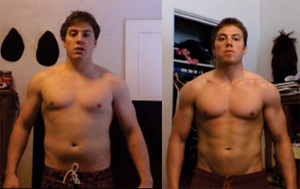Dear Davey,
I’m 44 years old and weigh 327 pounds. In the last 20 months I have lost 214 pounds. Yes, I used to weigh 541 pounds… and I’ve been overweight since I was 3 years old.
I came out in July of 2010 and started losing weight after I fell in love with a man that broke my heart. It threw me into a deep depression and I lost my appetite for several months. After not eating for 4 months, I had lost a considerable amount of weight and, when my appetite returned, I limited my meals to just one per day and that is how I have continued to lose weight.
Even though I go to the gym, my weight has slowed down in the last couple of months and now I am struggling to lose weight. Is there anything more I can do activity wise to speed up my weight loss?
Regards,
Al
Dear Al,
I’m really touched by your story.
Congratulations, first and foremost, on coming out of the closet. I think you’ll agree that life is too short to spend it hiding who you are.
Though your weight loss journey didn’t start under the best circumstances, perhaps your situation is an opportunity-in-disguise to create a new, healthier lifestyle for yourself. But because of the underlying issues and depression, I would encourage you to reach out to a trained professional.
I’m not surprised that your weight loss has plateaued.
Our bodies are very smart. When you starve your body, your metabolism comes to a crawl; your body tries to burn as little calories as humanly possible to stay alive. Your body goes into survival mode.
When you do eventually start eating again, you’re stuck with this slower metabolism. Because you are consuming calories and burning very few, it’s very hard to lose weight. And continuing to starve your body with only 1 meal a day isn’t helping.
There are two things you need to do: Eat and exercise.
Your body needs food - and you need to feed it. Instead of eating one meal a day (and wrecking havoc on your body’s metabolism), opt for three well-balanced and nutritionally-sound meals. This government website provides guidance for building a healthy plate of food with appropriate portions. In short, it’s about selecting lots of veggies, some fruits, whole grains, protein and dairy.
Beyond three meals, give your body healthy snacks in between. A handful of unsalted nuts or an apple or carrot sticks and hummus will help curb hunger throughout the day. And be sure to drink lots of water; it nourishes your body and boosts your metabolism. Speaking of boosting your metabolism, here are 9 effective ways to do just that!
When it comes to exercise, it’s great that you’re hitting the gym. Exercise will get your heart pumping and it will incinerate calories - even after your workout is complete. Make sure your combining both cardiovascular exercise and strength training as both are needed to maximize your results. And if you’re feeling unsure or uncomfortable at the gym, it’s always a wise idea to hire a personal trainer (even if it’s just for a few sessions).
Again, I’m very touched by your story - and I wish you the best of luck as you transform your body and your life.
Love,
Davey
If you have a fitness question for Davey Wavey, ask him!











